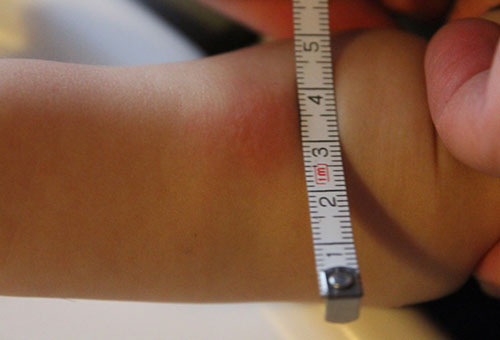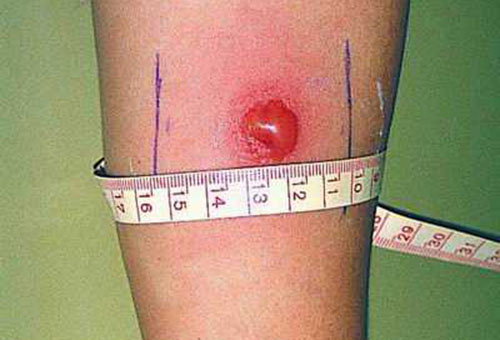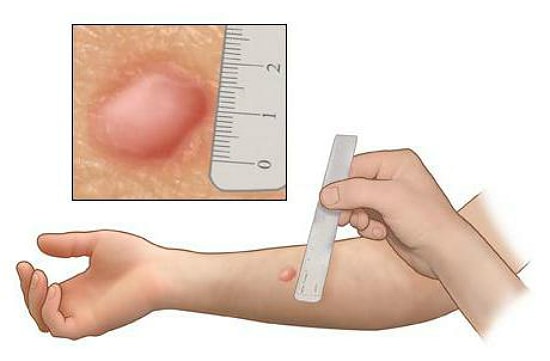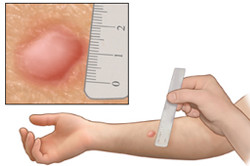Greetings, readers of my blog!
The Mantoux reaction is a well-known procedure carried out at school and in kindergarten. Any deviations in the results of the test cause a storm of parental emotions. Let's discuss today what it means if Mantoux is increased?
The Mantoux reaction is an annual procedure carried out by children in schools. This is how the presence of the causative agent of tuberculosis in the baby's body is checked. The Mantoux test is a regular vaccination, after which a papule appears on the second or third day - a small reddish elevation. In fact, this is not a vaccine, but really a test.
The more pathogens in the baby's body, the wider the seal will be. Depending on the size of the papule, the result is determined:
- negative - if the papule is absent or does not exceed 1 mm;
- doubtful - the size of the papule is from 2 to 4 mm;
- positive - the size of the papule is up to 5 to 16 mm (depending on the degree of infection);
- hyperergic - diameter more than 17 mm. This means that the child is infected and the disease is acute.
However, dear readers, it should be remembered that there can always be a false positive result when contraindications to Mantoux, the presence of an allergy to tuberculin in the baby, and recent infections were not taken into account.
Before raising a panic, you need to find out the reasons for the increase in Mantoux, and they may not be related to the disease in any way.
Why is the papule enlarged?
Unfortunately, there are many subjective factors that make Mantoux's results untrue:
Allergy
If the child is prone to allergies, then the probability that the papule will be increased is 80%. Allergy can manifest itself not only to tuberculin, but also to other irritants. If the doctor was not warned about this in advance, he may think that the baby has a positive reaction.
Poor quality vaccine
Unfortunately, in our enlightened age, this also occurs, and quite often. Improper storage of the vaccine and an attempt by manufacturers to save money leads to a decrease in the quality of medical products.
What to do in this case, it is difficult to advise. The only way out is to make Mantoux after a while in another clinic.
Human factor
It happens that the doctor, due to fatigue or inexperience, took the wrong measurements. It does not make sense to double-check on your own: this should be done by a person with a medical education, since the procedure is not as simple as it seems.
If the child was checked by Mantoux at school, take him to the pediatrician at the clinic and ask him to take a measurement.
Individual characteristics of the organism
If the child eats a lot of protein foods (eggs, milk, meat), or has a hereditary reaction to tuberculin, the result may be positive. In this regard, on the eve of vaccination, protein products should be excluded from the diet.
Tuberculosis
This is the worst option when your baby is really sick or is a wand carrier. It may not manifest itself in any way until a certain point, but such a child is registered in a tuberculosis dispensary, and parents should carefully monitor his health, lifestyle and nutrition.
The frequency of false positive results also increases due to the negligent attitude of the school's medical staff themselves. As a rule, they do not warn parents that tomorrow or in a few days the child will undergo a Mantoux reaction.
Moreover, they are not always interested in what the baby was sick recently, whether he has a runny nose, how he feels. Vaccinations are given to everyone in a row, fearing that parents will write refusals. Hence, there are so many problems with unexpected results in perfectly healthy children.
Hike to the phthisiatrician
Parents go into a real panic when a child is found to be positive and sent to a tuberculosis dispensary for examination by a phthisiatrician. There is no need to be afraid of this, because sometimes a more experienced specialist, after a careful examination, can determine that the increase in the papule was false.
What threatens a trip to a phthisiatrician will become clear if you stop worrying and prepare for this meeting with all responsibility. Prepare the following documents:
- an extract from the child's outpatient card, which indicates vaccinations, including BCG;
- take blood and urine tests in advance and take the results with you;
- whether it is necessary to do an x-ray, each parent decides on his own, but the phthisiatrician will most likely send the child for fluorography, therefore, if it has not been done within a year, it is better to immediately take a referral;
- the results of fluorography of all family members who live with the child.
What can a phthisiatrician do?
- Conduct an inspection;
- Collect anamnesis;
- Check the tests you brought, x-rays;
- It will measure the Mantoux reaction (in order for the measurement to be accurate, it is better to go to the phthisiatrician within 6 days after vaccination).
This is a diagnostic minimum, on the basis of which it is possible to draw a conclusion about the health of the child. If everything is fine, you will be allowed to go home.
In the case of a positive result in the absence of pronounced symptoms, but the carriage of the wand, the baby is registered in the tuberculosis dispensary, he is closely monitored, isoniazid is prescribed, as well as appropriate treatment.
Parents should remember one thing: an enlarged papule after Mantoux is not a sentence, but an occasion to carefully consider the health of the child.
Mantoux is one of the mandatory vaccinations, and it is regularly given to every child. A simple and almost painless procedure allows you to identify whether the causative agents of tuberculosis, a rather dangerous and contagious disease, are present in the child's body. The reaction of the child can be different - negative (no external manifestations) and positive (swelling and redness of the injection site). Restless parents, seeing an increase in the mantu of their child, panic. Does it make sense to be so worried? Is it worth taking such a reaction of the body as a sign of tuberculosis? It turns out that an enlarged mantle in a child can have various reasons, among which there may be not only lung disease.
If a child is allergic to animals, for the three days that must pass before checking the mantoux, it is better to take pets out of the house
Children often suffer from various forms of allergies, and this is one of the reasons for the increase in mantoux on a child's pen. If parents know the allergen to which their baby reacts in this way, it must be excluded from the child's life for those three days when tuberculin is in the body. If the allergen is unknown, it is better during this period to save the baby from:
- contact with animals;
- eating red foods and sweets;
- drug treatment.
If it was an allergy that was the cause, you need to give the baby an antihistamine (as prescribed by a doctor), and it is better to get vaccinated again. The doctor who will check the body's reaction to the mantle must be warned that the child has an allergy.

Unfortunately, free drugs are not always of high quality, and this should be taken into account when finding out the reason for a positive mantoux reaction.
Mantu is made to all children for free, but everyone knows that in modern world may refer to such a service. A low-quality vaccine, which will give a positive result, can be delivered to a medical and even a children's institution. There is only one way to identify an error - after three days after measuring the mantoux in a child that did not satisfy you, contact another medical institution (preferably paid) for re-vaccination. This will help you draw the right conclusions.

The human factor in medicine plays an important role, and the conclusion that the Mantoux reaction is positive may simply be erroneous.
Most parents unconditionally trust doctors. If, after the measurements, the doctor said that the mantoux in the child is enlarged, then this is the way it is. However, in this profession there is human factor. The doctor could:
- be inexperienced;
- do not take into account the individual characteristics of the body of a small patient;
- use the wrong ruler (there were such cases!);
- it's easy to make a mistake at the end of a working day, when hundreds of children's mantas flashed before my eyes.
It makes sense to double-check the results of measurements. However, it is better not to try to do it yourself. The procedure seems to be easy only in appearance. You need to ask a person with a medical education to measure the manta.

There are children who, for various reasons, have a positive Mantoux reaction in any case, while there is not even a hint of tuberculosis in the body.
Another common reason is the individual characteristics of the child's body. In such children, the swelling at the site of the puncture will persist throughout their lives, and at the same time they will have absolutely healthy lungs. This may be due to:
- hereditary factor: perhaps someone in the family reacts to tuberculin in the same way all his life;
- an abundance of protein foods in the diet: if your child is fond of eggs, dairy products or meat, it makes sense to limit the amount of these foods in his daily menu during the test three days.
In other cases, the reasons for such an individual reaction of the child's body remain unknown even to medicine. However, this can serve as a good consolation for parents: it means that your baby is healthy.

This is what a mantoux test looks like in a person infected with tuberculosis
One of the saddest reasons for an increased reaction to tuberculin in children, which signals the presence of a pathogen in the baby's body. Often it never develops into a disease, but the child will always be at risk. This must be remembered constantly and prevent pulmonary and catarrhal diseases from him.
Knowing what reasons can cause an increase in mantoux in a child, parents will worry less and think about the bad. On the other hand, after analyzing the condition and health of the baby, they can raise the alarm in time and get advice from a phthisiatrician or pulmonologist who will confirm or refute the diagnosis.
03.05.2011, 22:50
they did it today in the Mantoux kindergarten ... The child says that he didn’t wet it with water .. And for some reason, a swollen spot around the injection site with a diameter of 1.5-2 cm is approximately ...
I don’t remember something - so it was before, in previous years ...
Child 6 years old...
What is this reaction? maybe an allergic reaction? can give Zirtek or Suprastin? (child allergic)
Or is that the first day?
03.05.2011, 22:52
mantoux is measured after a strictly defined time
03.05.2011, 23:11
wait, it happens.
03.05.2011, 23:57
don't panic, it happens. Then they check not by a spot, but by a button.
04.05.2011, 00:12
04.05.2011, 14:55
If it’s really 1.5 - 2 cm, then they will send you to the tube dispensary to do the Perque reaction ... They won’t even ask, they wetted it - they didn’t wet it: 008: They are obliged to send with such a reaction. Moreover, if this has not happened before, it means a turn. This year we have 16mm, they sent it to a tube dispensary, today we went, did Perke (or Pirke - how right?: 008 :) They also said to bring a fluorography of all adults living with a child.
Maybe with a fright it seemed to you that 2 cm? Maybe less, well, there mm 14-15? Although it's still a lot ... The upper limit of the norm is 17 mm.
Antihistamine can be given, but now it will not help much ... Who is afraid of an allergic reaction (or knows for sure that there is an allergy to tuberculin) - they give antihistamines 2 days before Mantoux and then every day until the test.
They explained everything to us today in the dispensary ... If Mantou is big, they make Perke. If it's bad again - then Diaskintest (but not earlier than a month after Mantoux). And then on the basis of this they make a diagnosis. If it's just "tuberculosis" - then it's okay, tubercular infection is not a disease of tuberculosis, the child can simply be a carrier of the infection, but not get sick with tuberculosis (in the sense that treatment is required). We have 99% of the adult population TB-well, at least that's what they said in the dispensary.
And it could also be just an allergic reaction, then it won’t reach Diaskintest, Perke will show everything.
In general, do not worry, most likely - nothing to worry about. My allergy to tuberculin manifested itself at the age of 8 (before that, for some reason, I didn’t have it :))) Passed all the tests, recognized the allergy and fell behind. Although Mantoux was still regularly done at school, and the reaction was consistently great. And by the way, maybe my child will have the same thing now (we are 7 years old):)
what day is it measured?
04.05.2011, 14:58
What is Perk? where do they do it, in Helix do they do a blood test from a vein?
Today the spot is smaller, 1.5 cm.. and there is no swelling... can it go away?
what day is it measured?
Pirque reaction
Pirke reaction, Pirke test, skin allergic diagnostic test to detect hypersensitivity of a person to the causative agent of tuberculosis. Proposed by the Austrian pathologist and pediatrician K. Pirquet (S. Pirquet; 1907). A drop of tuberculin (a drug made from killed tuberculous mycobacteria) is applied to the skin of the forearm after a preliminary incision. The result is taken into account after 2-3 days, focusing on the amount of swelling at the incision site. Positive P. r. can be the result of both contact of the organism with the causative agent of tuberculosis (infectious allergy), and anti-tuberculosis vaccinations (post-vaccination allergy). The test is used to detect children infected with mycobacterium tuberculosis in preschool institutions and schools. Children with newly diagnosed positive Etc. referred to a phthisiatrician for examination. With widespread intradermal vaccinations against tuberculosis, the sample loses its diagnostic value. However, modified versions of the sample are used in phthisiology to determine the activity of the process. A more sensitive intradermal tuberculin test is used to select uninfected individuals for intradermal immunization.
Yes, wait for you to measure the result and stop winding yourself up.
Sometimes in children, the reaction to Mantoux may seem positive. But don't panic right away. The child has big mantou maybe not only because of the detection of Koch's bacillus in the body. An increase in size may be due to a careless attitude to the vaccination site or simply an allergic reaction. But if you suspect it is better to consult a doctor for the necessary research. After all, only the subsequent delivery of tests, or a thorough examination, will be able to determine what this means.
For many years, the diagnosis of tuberculosis in children and adolescents has been carried out in response to the Mantoux test. The method allows you to determine the need for a full-fledged preventive treatment for tuberculosis.
Mantoux test- this is an injection of the drug Tuberculin intradermally. Bacteria injected into the skin attract blood cells that are already familiar with tuberculosis microbacteria. To familiarize the body with tuberculosis, a newborn child needs to be vaccinated with BCG. After the first injection, the body produces T-lymphocytes for the subsequent destruction of the tubercle bacillus.
Inflammation appears at the injection site, which is measured to determine the presence of tuberculosis bacillus. Vaccination is done once a year until the age of 18. If the first BCG vaccination was not done at birth, then from the age of half a year, vaccination is done 2 times a year until BCG is done.
Variants of the Mantoux reaction

After the vaccination is completed, the Mantoux reaction appears. A wound from the needle necessarily remains in place, and a red spot or papule may also form. The size of the reaction depends on the number of blood cells reacting to tuberculin. The Mantoux reaction can be negative, doubtful or positive.
Negative reaction is determined when there is no skin damage at the injection site, except for the puncture. Redness or papule is completely absent. In this case, a follow-up consultation with a doctor is not required. The body either successfully fought off the infection on its own, or the child had no contact with the wand at all.
Doubtful reaction It is determined when a slight redness appears at the injection site. The maximum size of the papule with this reaction becomes 4 mm. There are no seals at the site of redness. In this case, it is impossible to determine the presence of a stick by the appearance of Mantoux. The child is sent to the phthisiatrician, who will indicate what to do next.
If a large Mantoux reaction in a child is clearly visible, then there is a reason to worry about his health. This sign means that reaction is positive. But there is no need to panic. In most children, this may simply be an allergic reaction to the drug. The papule reaches a size of 5 mm or more.
A positive degree of reaction can be mild, moderate, highly pronounced or excessive (hyperergic).
In case Mantou big size and pronounced, it is necessary to consult a doctor, especially when:
- the child had contact with a person who has an open form of tuberculosis;
- the child was in a region where tuberculosis is widespread;
- a family member of the child had tuberculosis.
What is Virage?

If the papule regularly increases with each subsequent vaccination, the pediatrician concludes about such a phenomenon as Virage. Tuberculosis is diagnosed if:
- the infiltrate was greater than 5 mm, and the previous test was negative;
- the papule is larger than 16 mm, regardless of previous check;
- 3-4 years after vaccination with bacillus Calmette-Guerin (BCG), the infiltrate becomes more than 12 mm;
- the reaction of the Mantoux vaccination became 6 mm more than the previous one.
Children who have a Virage phenomenon must be referred to a phthisiatrician. The child is registered in a tube dispensary, after which specialists are engaged in examinations to identify Koch's bacillus in the body.
Allergy to the drug

In the event of a reaction that indicates a positive result for tuberculosis, you should immediately consult a doctor. It is he who will determine what is the reason for such a reaction, and what to do next. In children aged 2-3 years, an allergic reaction to the drug tuberculin quite often occurs. In this case, the papule can reach 16 mm. This phenomenon happens because at this age, if BCG was made at birth, the body produces maximum immunity to tuberculosis.
If a large Mantoux occurs in an older child, then this may still indicate a post-vaccination allergy. The pediatrician determines the allergy, but if its nature is not established, the following measures are taken:
- the conclusion of an allergy of unclear etymology is made;
- the child is sent to the TB dispensary for examination
- the child is registered in the zero observation group;
- the Mantoux test is done again, after half a year.
If the child has a bright papule with a clear contour and pigmentation, infection is usually diagnosed. Therefore, you should not calmly blame the allergy for inflammation. It is necessary to closely monitor the development of inflammation. The conclusion is made in a week or two after vaccination.
Final definition of infection
![]()
In order to determine exactly why a child has a large Mantoux, more research is being done. It is impossible to judge a positive result only by the size of the inflammation. In order to confirm the presence or absence of tuberculosis infection, carry out:
- fluorography of the chest;
- sputum examination
- blood test;
- graduated and standard Pirquet test;
- enzyme immunoassay;
- determination of the polymerase reaction;
- serological analysis.
Vaccination contraindications
Sometimes the result may be incorrect, due to the fact that the characteristics of the child were not taken into account, which may distort the reaction. What an incorrect test result may depend on is called contraindications:
- various infectious diseases;
- asthma;
- chronic diseases;
- the body's tendency to allergies;
- epilepsy;
- dermatological diseases.
Additional factors that may distort the result of the check

Before carrying out the procedure, it is extremely important to take into account all the factors that may affect the sample. In addition to the above contraindications, there are other circumstances that distort the result. The fact that the papule is swollen may be affected by recent vaccinations, intolerance to the drug (allergy), worms, or a low-quality vaccine.
Very often, the cause of a distorted result is improper care of the injection site. To avoid a false positive reaction, the vaccination site should not be: wet, rub, scratch; close it so that it is rotten, for example, with adhesive tape; wash with soap or shampoo; treat with an antiseptic.
- How to properly care?
The reasons for the deviation from the reaction norms after Mantoux vaccination are very different in children. When a large Mantoux occurs in a child, parents should not try to make a diagnosis on their own, since specialists carry out an analysis based on many different factors. Therefore, when asked whether it is worth going to the doctor with such a seemingly stupid problem or not, the answer is unambiguous, of course.
You should be aware of the possible risks with such deviations, because both infectious diseases and a common allergic reaction can manifest themselves in this way.
What you need to know about the Mantoux test?
Tuberculin diagnosis or Mantoux test is the main method for checking the early manifestation of tuberculosis in a child or adolescent. Thanks to this method, it is possible to accurately identify diseases such as tuberculosis in children and adolescents who need targeted preventive treatment.
With the Mantoux test in children, tuberculin is injected into the arm under the skin, in the middle between the inside of the elbow and wrist, after which inflammation develops in this place, which is caused by the accumulation of lymphocytes. The injected extracts of mycobacteria play the role of a "magnet" for blood cells, which are responsible for cellular immunity. But not all cells are attracted, but only those that are already familiar with Mycobacterium tuberculosis. Therefore, the more such cells are identified, the stronger the inflammation. It is due to such inflammatory processes that an assessment is made regarding the presence of a tubercle bacillus in the body.
 The Mantoux test is done to all children vaccinated against tuberculosis annually from 1 year to 18 years of age. In cases where the baby has not been vaccinated, a tuberculin test can be done 2 times a year, starting from 6 months of the baby's life and until the moment when the child is vaccinated with BCG.
The Mantoux test is done to all children vaccinated against tuberculosis annually from 1 year to 18 years of age. In cases where the baby has not been vaccinated, a tuberculin test can be done 2 times a year, starting from 6 months of the baby's life and until the moment when the child is vaccinated with BCG.
It is impossible to evaluate the results of the Mantoux test after the first vaccination, only the dynamic reaction of the child's body will show the presence and predisposition to the disease.
Back to index
Self-determination of the reaction
Before rushing to see a doctor, you should determine the general results of the test at home after 3 days.
The photo shows what a normal one should look like. In the absence of obvious redness on day 2, and the compaction does not exceed 1 mm, you can be calm, this is a normal, negative reaction to the tuberculin test. A doubtful result can be considered an excess of the "button" of 4 mm, as well as with the manifestation of only redness.
It is customary to consider the formation of a seal more than normal - from 5 to 16 mm. A positive reaction can also be hyperergic, which has the form of a seal of more than 16 mm, or in cases where small ulcers and abscesses form at the injection site. This indicates that a significant amount of bacteria has entered the body and, accordingly, the possibility of infection with tuberculosis.
 A false positive reaction is the result of a Mantoux test, similar to a positive one. The difference is that a large “button” often occurs due to improper sample care:
A false positive reaction is the result of a Mantoux test, similar to a positive one. The difference is that a large “button” often occurs due to improper sample care:
- getting wet;
- combing;
- closing;
- friction, etc.
With the last 2 reactions, the doctor can send the child with his parents to the TB dispensary, where it will be necessary to consult with a phthisiatrician and pass several additional tests.
Back to index
How to properly care?
In order not to provoke the manifestation of a false reaction to the Mantoux test, you should act correctly and correctly within 3 days.
- Within the allotted time, it is not recommended to wet the vaccine, that is, take a shower, bath, etc. But also deprive the child water procedures completely does not follow, since the ingress of dirt into the puncture site is fraught with the occurrence of even more dangerous infections.
- Do not rub the sample site as this may cause induration and redness.
- Do not come into contact with allergens. Less contact with animals, do not eat a lot of citrus fruits and red foods.
- If there is induration or a slight increase in redness, give the child something of an antihistamine.
- When a hand with a vaccination gets wet, the doctor who will measure the Mantoux reaction must be reported without fail.
- You can not close the puncture site with various plasters and bandages, and it is also not recommended to lubricate this place with anything.
Since the incidence of tuberculosis is far from small, and the infection is serious, parents need to follow the Mantoux vaccination schedule for their child, which will control the spread of the disease.
Thanks for the feedback

